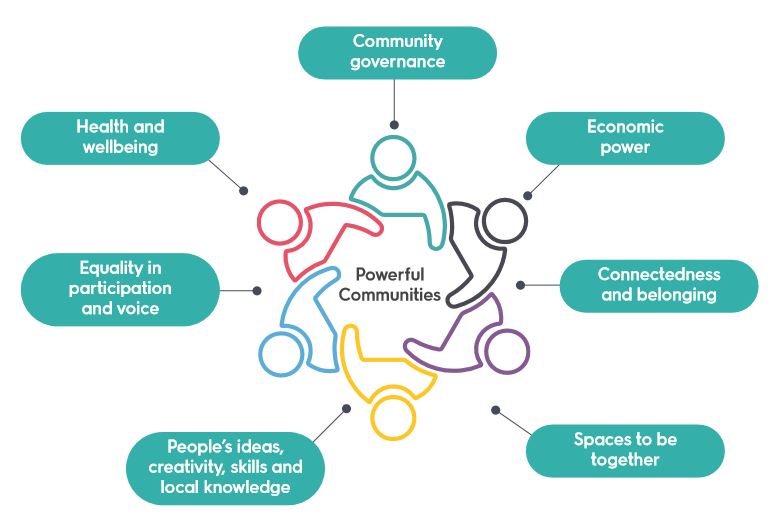The way communities can influence and control their own positive and sustainable development is a subject that preoccupies practitioners, academics, and committed villagers alike. In my last post, I announced I’d be writing about a special form of organisation to promote local development: what are known as “Community Development Trusts“.
 In view of the financial and organisational difficulties of municipal administration and the generalised withdrawal of the state from the local level, civil society forms of organisation play an increasingly important role in establishing and implementing development projects, as well as performing crucial tasks for the community (for instance, basic service provision). During my professional career, I have encountered various organisational examples of this kind: committed citizens’ associations, charitable foundations or partnerships consisting of administration, business and civil society such as the Local Action Groups in the context of the European LEADER programme for rural development.
In view of the financial and organisational difficulties of municipal administration and the generalised withdrawal of the state from the local level, civil society forms of organisation play an increasingly important role in establishing and implementing development projects, as well as performing crucial tasks for the community (for instance, basic service provision). During my professional career, I have encountered various organisational examples of this kind: committed citizens’ associations, charitable foundations or partnerships consisting of administration, business and civil society such as the Local Action Groups in the context of the European LEADER programme for rural development.
In the next two posts I would like to explain a bit about how the organisation that I am cooperating with in the practical phase of my dissertation actually works and what exactly it does. To do so, in this first post I will give you some general insights into this particular form of organisation in the UK. In the second post, I will look at the inspiring history of the “Glendale Gateway Trust” in Wooler and report on its activities in Glendale. Due to the trusts being widespread in the English-speaking context, in my opinion, this particular form of organisation will be of special interest to German and Spanish-speaking readers of the blog.
 So let me start with some history. According to the former Association of British Community Development Trusts (former DTA – nowadays Locality), a few years ago 500 such organisations existed in the United Kingdom. Their historical origins date back about 140 years to their roots in the social reform movement of the “Settlement Movement” which laid the foundation of community work in response to the poverty brought on by industrialisation. During the 20th century, this movement founded the principles of the social welfare state: universal education, health care, and adequate housing and legal support for the general population (Locality, 2018).
So let me start with some history. According to the former Association of British Community Development Trusts (former DTA – nowadays Locality), a few years ago 500 such organisations existed in the United Kingdom. Their historical origins date back about 140 years to their roots in the social reform movement of the “Settlement Movement” which laid the foundation of community work in response to the poverty brought on by industrialisation. During the 20th century, this movement founded the principles of the social welfare state: universal education, health care, and adequate housing and legal support for the general population (Locality, 2018).
Development Trusts as they exist today are a relatively new phenomenon and have grown over the past 40 years under many different influences and inspirations. They have placed more emphasis on economic development and on administering community buildings than many organisations in the traditional voluntary sector concerned with social welfare. Activists founded the pioneer trusts in the UK in the 1970s going beyond traditional campaigning and regaining real estate and other assets for local communities. Thanks to increased hiring of professional instead of volunteer staff, these types of organisations were able to evolve and assert themselves at local and regional level.
During the late 1980s and early 1990s, existing trusts were financially supported by governments in power and new foundations were sponsored. By the end of the 1990s Development Trusts and similar partnerships were an essential component of urban and rural regeneration programmes (partnerships.org, 2018).
The former Development Trusts Association, in its introduction to trusts, says:
“Because development trusts respond to local needs, no two are alike”. Because they recognise that to regenerate a community (such as a neighbourhood, small town, or village) means adopting a comprehensive approach, they are involved in a wide range of activities.
What does that mean exactly? A development trust actually works like a business. Development trusts are enterprises working in the public interest, created at local level by communities to enable sustainable development in their area. They undertake a wide range of economic, environmental and social activities and services. The legal structure of Development Trusts is most frequently that of a company limited by guarantee. That is one which has members instead of shareholders and which does not distribute any surpluses as profits to members, but instead – due to its association articles – reinvests them. Because the activities of trusts are frequently charitable, many trusts apply for charitable status. This provides some tax advantages and a public identity, which assures their probity (partnerships.org, 2018).
 As independent and not-for-profit organisations, they are committed to participation and accountability to the local people and interest groups. Development trusts are part of the community and social enterprise movement. This means they are community-based organisations engaging in trading, growing enterprises, providing services and working alongside the local voluntary sector, public authorities and private sector (DTA Wales, 2018).
As independent and not-for-profit organisations, they are committed to participation and accountability to the local people and interest groups. Development trusts are part of the community and social enterprise movement. This means they are community-based organisations engaging in trading, growing enterprises, providing services and working alongside the local voluntary sector, public authorities and private sector (DTA Wales, 2018).
They aim to achieve their goals by making profits through trading and securing building and managing assets for their communities such as buildings, land and equipment.
These profits are not-for-private-benefit or gain, or distributed to individuals, but are used to create community wealth and are reinvested with a lasting impact on the renewal and improvement of an area.
The heart of the organisation is ultimately a team of employees who form the extended arm of the trusts. They carry out the day-to-day and operational work, coordinate decision-making and discussion boards (formed by trustees), acquire funding and implement projects, and interact with a wide range of local and regional stakeholder networks such as other local development initiatives, local and regional groups and associations, local government, small and medium-sized enterprises, research institutions, etc.
In my view, these organisations – actually, small development agencies – contribute in two ways to the positive development of villages, neighbourhoods or other forms of local communities. Through a combination of proximity to the needs of the community and their constitution as a company, they can improve their quality of life and development prospects with the help of dynamic and long-term, economically viable measures and projects. Thus, on the one hand, they create concrete, positive results for the community and its reference area.

Ⓡ Locality 2018
On the other hand, the way they work as development agencies is a value in itself. The way a Community Development Trust is organised can make an important contribution to consolidating local and regional governance.
Through their networked approach, the fact that they emanate from the local grassroots movement and their entrepreneurial mindset, they are in a special position to unleash community potential at a local level.
In this context, there is still much to be said about the conflicts, risks and challenges of these organisations on the way to becoming genuine platforms for local and regional development.
But I don’t want to overstretch your attention! I hope I have been able give a rough idea of how a community development trust can help a village community keep the reins of development in its own hands. I would like to look further into the subject, which I intend to do in the second post of this series, using the example of my partner organisation – the “Glendale Gateway Trust“.
If you have any questions or comments, I’ll be happy to answer them directly in the blog or in social networks. This coming week I’m going to be at the OECD Conference on Rural Development in Edinburgh which I will be reporting on in this blog. So, until next time!

I’m wondering in what way are trusts such as the Glendale gateway, committed to participation and accountability to the local people and interest groups? Would you be able to provide examples of accountability?
Hello Ms Moon,
I am no specialist on the topic, but as far as I understand the origin of accountability lies in the so called “governing documents” of the trust. Constituting a trust as a company limited by guarantee usually preparing following documents: a) memorandum of association and b) articles of association. It is up to the founders to secure methods of popular consultation, of democratic decision-making, of representation of local people and groups in the executive bodies of the trust (board of trustees) in these documents. If you would like to know more in detail I would advise you to contact locality.org. You can read more here -> http://partnerships.org.uk/pguide/create.htm also here -> http://www.hie.co.uk/community-support/managing-community-funding/openness.html
Thanks for your comment!